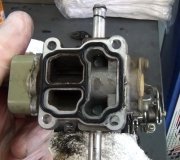First of all, if the battery was recently disconnected or run dead, the Engine Computer lost its mind and must relearn "minimum throttle" before it will know when it must be in control of idle speed. To do the relearn procedure, you must make the engine meet the conditions at which this will occur. Drive at highway speed with the engine warmed up, then coast for at least seven seconds without touching the brake or gas pedals.
If it's not batery related, you'll need a scanner, a hand-held computer to read the sensor values and idle control "steps". Most aftermarket scanners should do this but I use the Chrysler DRB2 and DRB3. There are 256 "steps" the computer will set the Automatic Idle Speed (AIS) motor to. That's the part you replaced. For a properly running engine, step 32 is a typical step for a normal idle when warmed up. If you find it's around step 50 or higher, the computer is trying to increase engine speed but not getting the desired response. Look for carbon blocking the air passage the AIS sits in. If the steps are 0 or real low, the computer is trying to slow the engine down or it hasn't learned minimum throttle yet.
Also look at the temperature the Coolant Temperature Sensor is reporting. If it is not in line with the ambient air / battery temperature sensor when the engine is cold, the computer will know it can't trust that sensor. It will try to make judgements based on other sensor readings. The results are less than perfect, but the engine will run. Normally a conflict between various sensors during various conditions will be detected by the Engine Computer which will memorize a diagnostic fault code and turn on the Check Engine light.
Caradiodoc
caradiodoc
SPONSORED LINKS
Sunday, February 28th, 2010 AT 8:03 AM




